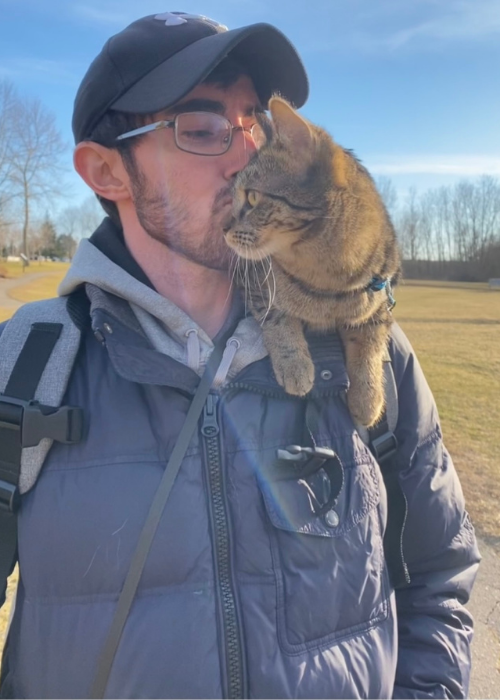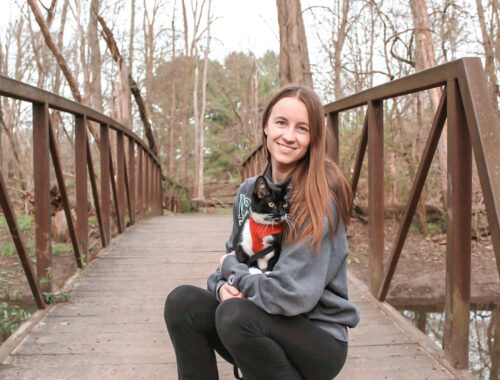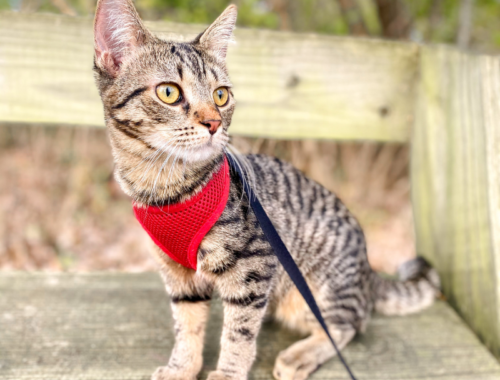
How To “Shoulder Cat” On Adventures
You may have heard the term “shoulder cat” on Instagram before, so what does that mean? Well, it simply means when cats like to sit up on their owner’s shoulders when they’re walking. Many adventure cats like to ride on their owner’s shoulders to get a good view of everything. Sitting up on your shoulder also allows your cat to see forward as you are walking. Many cats often prefer this, rather than seeing backwards when inside the backpack. This also allows your cat to be out of the backpack and can see more. Being a shoulder cat can be a great compromise for carrying your cat, but still giving them to views they want!
What You Need:
Backpack – Being a shoulder cat can involve a backpack as well, or not! Some cats like to sit on their owner’s shoulders or lay across the neck and shoulders. Other cats like to sit on top of a backpack and have their paws on their owner’s shoulders. Whichever way your cat prefers is just fine! There is no one way to shoulder cat! Mix it up and get creative!
Harness and Leash – having your cat on a harness and leash means that if they jump off your shoulder, you still have an attachment to them. If your cat is outside of their backpack, they should be connected to a harness and leash for their safety.
Trust – building trust is a part of adventure cat training in general. But it takes a certain level of trust for your cat to jump up on you and stay there. Read our post here on building trust here.
The great outdoors – once your training indoors is complete, take it outdoors safely!
Our tips for training your cat to be a shoulder cat:
- We recommend starting with clicker training. It has been a great training tool utilized by many cat owners (adventure cats or not) and has been an effective training method.
- Charge the clicker. This means click and give a treat. Do this a few times daily until your cat associates the clicking noise with a reward. See our post here on how to get started with clicker training.
- Teach your cat to follow the wand/target stick. Point the target stick on the ground somewhere, and once your cat touches it, click and give treat. Do this until they consistently go to wherever you point the target stick.
- Add some elevation. Have them jump up onto a chair. Place the target stick on the chair and when your cat jumps up and touches it, click and treat. Do this until they consistently respond.
- Add more elevation. Have them jump from the ground to a dresser or other object that is higher than the chair. Again, when they jump up and touch the stick, click and treat. Do this until the consistently respond as well.
- Next, have them jump from the dresser onto your shoulder. This makes the jump onto you less scary for them since you are at a more even height. Place the target stick on your shoulder and stand close to them. Let them just step onto instead of jumping if they prefer.
- Once they do that consistently, try to stand a little further away and have them jump onto you from the dresser.
- Once you have that step down, try from the chair, and then the ground.
Teaching your cat to jump up on you takes time and trust. It can be scary for them to jump onto you from a distance. When they do jump, you can try to catch them or support them as they get situated on your shoulder. This helps them feel more comfortable and safer knowing you will catch them and help if they are slightly off. Go slow and do not continue to the next step in training until your cat feels comfortable at that level.
Conclusion:
The term shoulder cat is what many adventure cat owners use when their cats sit on their shoulders. It is a creative and useful thing to teach your cat, as it is a helpful way to carry them. And many cats love to view too. It’s a win-win situation for everyone! Happy Hiking!

Meet Otje And Pluk
You May Also Like

Top 8 Things To Know Before Getting A Cat
September 25, 2020
Best Harnesses For Adventure Cats
December 25, 2020

